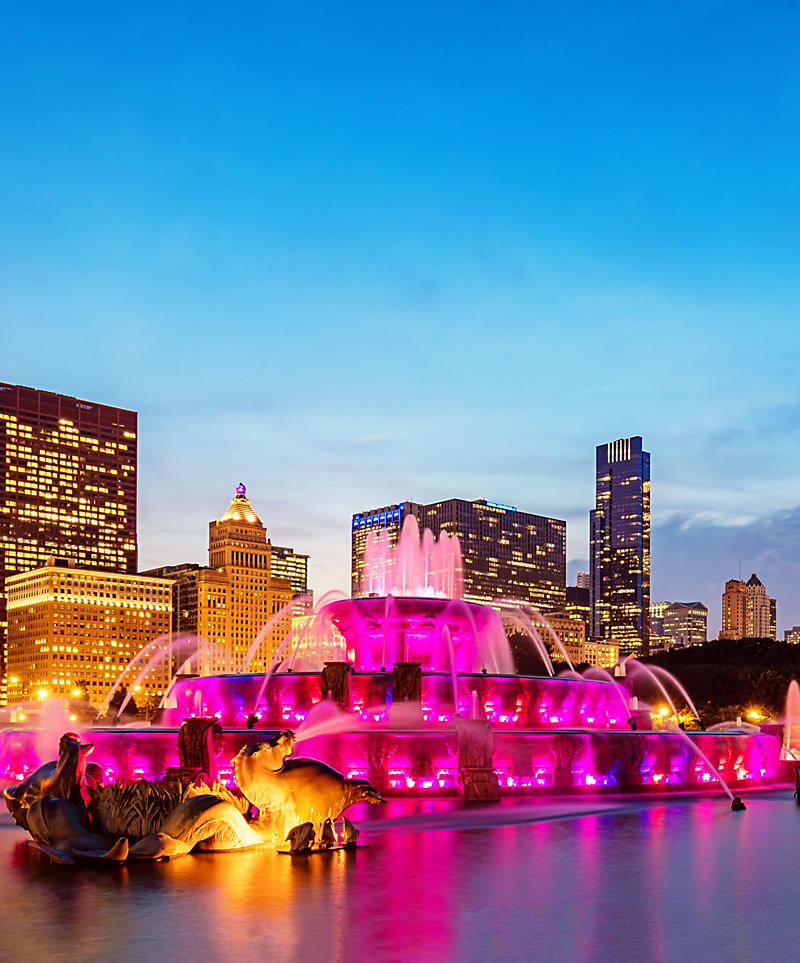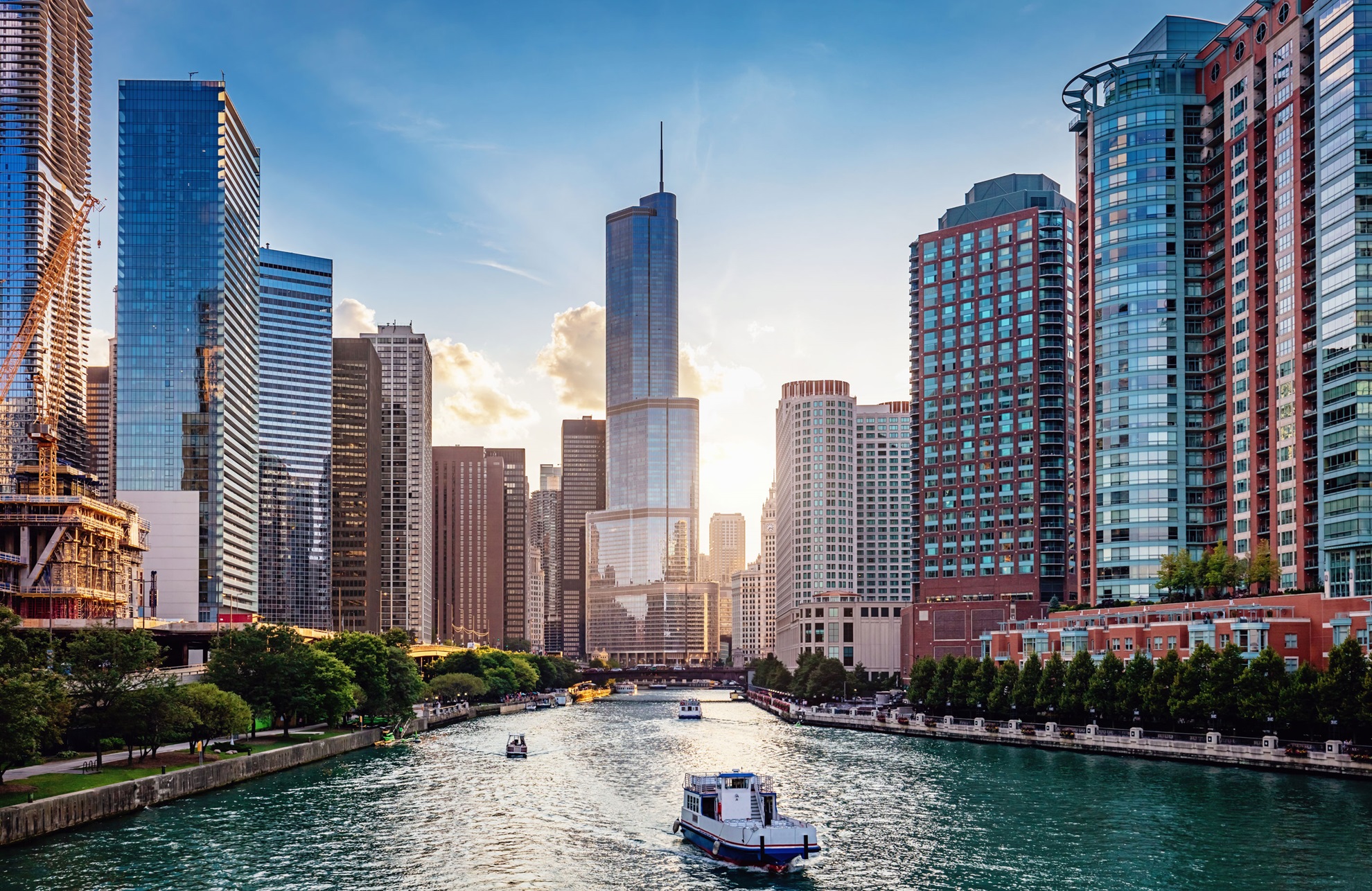Chicago, Illinois, offers iconic attractions like Millennium Park, The Art Institute of Chicago, and deep-dish pizza.
BOOK A FLIGHT





5700 S Cicero Ave, Chicago, IL 60638
Feels like 57°F. overcast clouds
moderate rain
light rain
heavy intensity rain
light rain
broken clouds
overcast clouds
light rain
Chicago, Illinois, is a vibrant city with a rich cultural heritage, stunning architecture, and an array of activities to suit every interest. Here are the top five things to do when visiting Chicago:
Explore Millennium Park and Cloud Gate (The Bean): Millennium Park is a must-visit for any trip to Chicago. It's home to the iconic Cloud Gate sculpture, commonly known as "The Bean," which reflects the city's stunning skyline. The park also features the Crown Fountain, Lurie Garden, and the Jay Pritzker Pavilion, which hosts free concerts and events during the summer months.
Take an Architecture River Cruise: Chicago is renowned for its architectural marvels, and one of the best ways to see them is from the water. An architecture river cruise offers insightful commentary about the city's history and the stories behind its most famous buildings, including the Willis Tower (formerly Sears Tower), the Wrigley Building, and the John Hancock Center.
Visit the Art Institute of Chicago: Art enthusiasts will love the Art Institute of Chicago, one of the oldest and largest art museums in the United States. Its extensive collection spans thousands of years and includes works from nearly every corner of the globe. Highlights include Georges Seurat's "A Sunday on La Grande Jatte," Grant Wood's "American Gothic," and a vast collection of Impressionist and Post-Impressionist paintings.
Walk or Bike the Lakefront Trail: Chicago's Lakefront Trail offers 18 miles of paved path along the edge of Lake Michigan, providing beautiful views of the city skyline and the lake. It's perfect for walking, jogging, or biking. Along the way, you can stop at beaches, parks, and gardens, making it a great way to spend a sunny day.
Experience the Skydeck at Willis Tower: For breathtaking views of Chicago and beyond, visit the Skydeck on the 103rd floor of Willis Tower. Step out onto The Ledge, a series of glass boxes that extend out from the building, if you dare, for a thrilling view straight down to the streets below.
These activities offer just a glimpse of what Chicago has to offer. The city is also famous for its deep-dish pizza, jazz and blues clubs, diverse neighborhoods, and historic sites like the Museum of Science and Industry and the Field Museum. Whether you're interested in culture, history, food, or outdoor activities, Chicago has something for everyone.
Getting to Chicago, Illinois, depends on your starting location and preferred mode of transportation. Chicago is a major city in the United States with a variety of transportation options available, including air, train, bus, and car. Here are some general guidelines:
From either airport, you can take taxis, rideshares (like Uber or Lyft), or public transportation (CTA trains) to reach downtown Chicago or other destinations.
Once in Chicago, the Chicago Transit Authority (CTA) provides an extensive network of buses and trains (the "L") to get around the city and suburbs. Taxis and rideshare services are also readily available.
Remember, the best way to get to Chicago will depend on your starting location, budget, and preferences.
Chicago, Illinois, is known for a variety of cultural, historical, and architectural landmarks, as well as its significant contributions to music, sports, and cuisine. Some of the key highlights include:
Architecture: Chicago is renowned for its bold architecture, with a skyline punctuated by skyscrapers like the Willis Tower (formerly Sears Tower), which was once the tallest building in the world, and the neo-Gothic Tribune Tower. The city is also famous for its innovative architectural styles and the Chicago School of Architecture.
Deep-Dish Pizza: This iconic food is synonymous with Chicago. The deep-dish pizza, with its thick crust and generous layers of cheese, sauce, and toppings, originated here and remains a must-try culinary experience.
The Chicago River and its Dyed Green Celebration: The Chicago River, which flows through the city, is famous for being dyed green annually in celebration of St. Patrick's Day, a tradition that attracts both locals and tourists.
Jazz and Blues Music: Chicago has a rich musical heritage, particularly known for its influential jazz and blues scenes. The city has been home to many legendary musicians and hosts several famous music festivals, including the Chicago Blues Festival.
Sports: Chicago is a passionate sports town, home to several major league sports teams, including the Chicago Bears (NFL), Chicago Bulls (NBA), Chicago Cubs and Chicago White Sox (MLB), and Chicago Blackhawks (NHL). The city is deeply loyal to its teams, and the rivalry between the Cubs and the White Sox is particularly notable.
The Art Institute of Chicago: One of the oldest and largest art museums in the United States, it houses a vast collection of works, including Grant Wood's "American Gothic" and Georges Seurat's "A Sunday on La Grande Jatte."
Theatre and Improv Comedy: Chicago has a vibrant theatre scene, including Broadway-style productions, avant-garde plays, and it is especially famous for its improv comedy, with The Second City comedy club having launched the careers of many famous comedians.
Historic Events and Figures: The city has a rich history, including the Great Chicago Fire of 1871, the World's Columbian Exposition of 1893, and notable figures such as Al Capone during the Prohibition era.
Lake Michigan and the Waterfront: Chicago's location along Lake Michigan provides beautiful beaches, waterfront parks, and opportunities for boating and other water activities, contributing to the city's scenic beauty and recreational offerings.
Cultural Institutions: Beyond the Art Institute, Chicago boasts other cultural institutions like the Museum of Science and Industry, the Field Museum, and the Adler Planetarium, making it a hub for education and culture.
These elements, among others, make Chicago a unique and vibrant city with a rich cultural tapestry and a significant place in American history and culture.
The most popular part of Chicago, IL, can vary depending on the criteria used (tourism, local popularity, cultural significance, etc.), but some of the most renowned and frequently visited areas include:
The Loop: This is the central business district of Chicago and is known for its iconic architecture, skyscrapers (including Willis Tower, formerly Sears Tower), the Art Institute of Chicago, Millennium Park (home to the famous Cloud Gate sculpture, also known as "The Bean"), and Grant Park. The Loop is also where you'll find the Chicago Theatre and a bustling theater district.
Magnificent Mile: Part of Michigan Avenue, the Magnificent Mile is famous for its luxury shopping, dining, and historic landmarks. It's a prime destination for tourists seeking high-end retail experiences and architectural beauty.
Navy Pier: A popular destination for both tourists and locals, Navy Pier extends into Lake Michigan and offers a variety of attractions, including rides, gardens, shops, restaurants, concert venues, and the Chicago Children's Museum. It's also a great place to enjoy views of the city skyline.
Wrigley Field: Located in the Lakeview neighborhood, specifically in an area known as Wrigleyville, Wrigley Field is the historic home of the Chicago Cubs baseball team. The area is not only popular for sports fans but also for its lively atmosphere, bars, and restaurants.
River North: Known for its vibrant nightlife, art galleries, and dining scene, River North is a trendy neighborhood just north of the Loop. It's particularly popular for its upscale eateries and the historic Merchandise Mart.
Millennium Park: Although part of the Loop, Millennium Park deserves its own mention for its status as a major gathering spot. It's home to the Jay Pritzker Pavilion, Crown Fountain, Lurie Garden, and numerous outdoor sculptures and art installations.
While these areas are among the most popular in Chicago, the city is diverse and expansive, with many neighborhoods and attractions drawing visitors for various reasons. The best part of Chicago often depends on individual interests, whether they lie in culture, history, sports, dining, or shopping.
As of my last update in 2023, the #1 attraction in Chicago, IL, often varies depending on the source and personal interests, but the Art Institute of Chicago is frequently cited as a top attraction. It is renowned for its extensive collection of Impressionist and Post-Impressionist paintings, among other significant works from various periods and styles. Other popular attractions include Millennium Park, home to the iconic Cloud Gate sculpture (often referred to as "The Bean"), and the Willis Tower Skydeck, offering panoramic views of the city. However, preferences can vary, and what is considered the #1 attraction might differ based on individual interests, such as architecture, art, or outdoor activities.
The ideal length of your stay in Chicago, IL, depends on your interests, the purpose of your visit, and how much time you have available. However, for a general visit aimed at experiencing a broad overview of what the city has to offer, including its most famous attractions, a stay of 3 to 5 days is often recommended. Here's a basic breakdown:
A 3-day visit allows you to cover the major highlights without feeling too rushed. You can explore the iconic Millennium Park and Cloud Gate (The Bean), visit the Art Institute of Chicago, take an architecture river cruise, and enjoy the views from Willis Tower Skydeck or 360 Chicago in the John Hancock Building. You'll also have time to explore some of the city's diverse neighborhoods, like the Magnificent Mile for shopping, or Wicker Park for its hipster vibe and street art.
With 4 to 5 days, you can delve deeper into what Chicago has to offer. In addition to the activities mentioned for a 3-day visit, you can spend more time in museums like the Field Museum and the Museum of Science and Industry. You can also explore more neighborhoods, enjoy the city's food scene (don't miss out on Chicago-style deep-dish pizza), catch a show at one of the historic theaters, or even attend a sports event, depending on the season. This timeframe also allows for more leisurely exploration or a day trip to nearby areas.
If you have more than 5 days, you can explore at a more relaxed pace, visit more museums, parks, and neighborhoods, and really immerse yourself in the city's culture. You could also consider day trips outside of Chicago, such as to Starved Rock State Park for nature or to explore other nearby cities.
Ultimately, how long you should spend in Chicago depends on what you want to get out of your visit. Adjust your stay according to what interests you the most, and remember, Chicago is a city with layers—each visit can offer new discoveries.